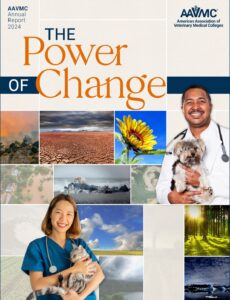Washington, D.C., March 14, 2018 – A new Competency-Based Veterinary Education (CBVE) program that aims to improve veterinary medical education and quality assurance was introduced during the recent conference of the American Association of Veterinary Medical Colleges (AAVMC).
It’s an outcomes-based, learner-centered approach to veterinary medical education that uses a shared framework and language to help ensure that every veterinary medical college student graduates with competencies that enable them to be successful from their first day as independent veterinarians.
“This framework, which represents the latest pedagogical thinking and best practices, lays the foundation for colleges and schools to develop competency-based education,” said AAVMC Chief Executive Officer Dr. Andrew T. Maccabe, noting that the CBVE program is one of the most substantial pedagogical initiatives ever undertaken by the AAVMC.
“Colleges and schools will benefit from a common language and a more comprehensive picture of graduate outcomes based upon evidenced-based criteria and agreed-upon standards from some of veterinary medicine’s best educators and the latest research,” he added. “It’s not a final product, but a first step in a journey of co-creation.”
The framework outlines a series of competencies that are core as well as sub-competencies that veterinary medical colleges can customize or use as guidelines for assessing veterinary medical students’ proficiency.
An outcomes-based, learner-centered approach to education first formally surfaced in the mid-70s but has only recently gained traction and become a trend, according to Dr. Jason Frank, an internationally recognized expert in competency-based medical education from the Royal College of Physicians and Surgeons of Canada. Frank opened the CBVE session at the AAVMC annual conference.
In 2015, the AAVMC formed the CBVE Working Group, consisting of 10 national and international veterinary medical professors. The working group built upon existing frameworks deployed in other areas of health education and incorporated extensive feedback from employer and graduate surveys.
Since its inception, the working group logged thousands of emails, over 100 videoconference meetings, 20 face-to-face meetings, 20 stakeholder engagements to gather input and ideas, two formal surveys, multiple expert consultations and communications with the AVMA Council on Education.
The resulting CBVE program seeks to clarify what abilities students need upon graduation and to elucidate steps that demonstrate the progression of necessary expertise.
It presents a framework of nine Domains of Competence and outlines specific, observable skills, knowledge, values and attitudes within each domain of competence: clinical reasoning and decision-making; individual animal care and management; animal population care and management; public health; communication; collaboration; professionalism and professional identity; financial and practice management; and scholarship.
It also presents eight Entrustable Professional Activities (EPAs) that outline what activities all students should be able perform without supervision in a workplace setting. They are: gather a history, perform an examination, and create a prioritized differential diagnosis list; develop a diagnostic plan and interpret results; develop and implement a management/treatment plan; recognize a patient requiring urgent or emergent care and initiate evaluation and management; formulate relevant questions and retrieve evidence to advance care; perform a common surgical procedure on a stable patient, including pre-operative and post-operative management; perform general anesthesia and recovery of a stable patient, including monitoring and support; and formulate recommendations for preventive healthcare.
The working group is currently developing milestones that represent steps in the mastery of competencies, on a scale from novice to proficient.
The CBVE working group was chaired by Dr. Laura Molgaard of the University of Minnesota and Dr. Jennie Hodgson of the Virginia Maryland College of Veterinary Medicine. Members include Dr. Harold Bok, Utrecht University; Dr. Kristin Chaney, Texas A&M University; Dr. Jan Ilkiw, University of California – Davis; Dr. Susan Matthew, Washington State University; Dr. Stephen May, Royal Veterinary College; Dr. Emma Read, University of Calgary; Dr. Bonnie Rush, Kansas State University; and Dr. Kathy Salisbury, Purdue University.
The CBVE program with downloadable booklets can be found on the AAVMC’s website here.
The AAVMC is a nonprofit membership organization working to protect and improve the health and welfare of animals, people and the environment around the world by advancing academic veterinary medicine. Members include 49 accredited veterinary medical colleges in the United States, Canada, the Caribbean Basin, Europe, Australia and Mexico.
– 30 –
AAVMC MEDIA CONTACTS:
Jeff Douglas or Jeanne Johnson
Phone: 202/371-9195, x144
Email: jdouglas@aavmc.org or jjohnson@aavmc.org





SHARE